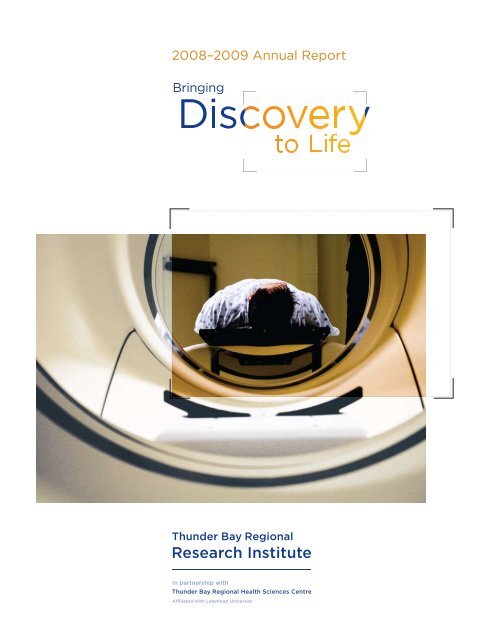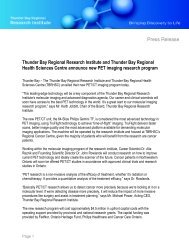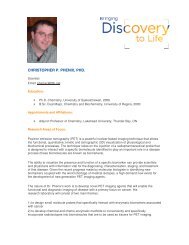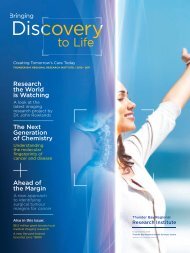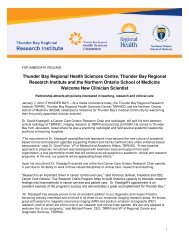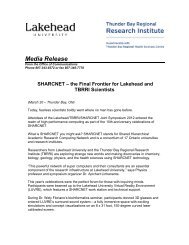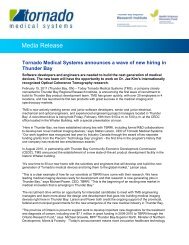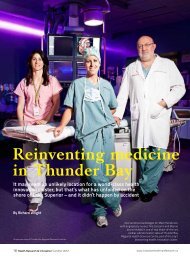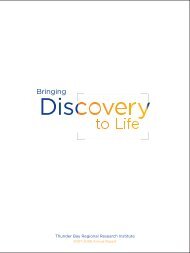2008â2009 Annual Report - Thunder Bay Regional Research Institute
2008â2009 Annual Report - Thunder Bay Regional Research Institute
2008â2009 Annual Report - Thunder Bay Regional Research Institute
You also want an ePaper? Increase the reach of your titles
YUMPU automatically turns print PDFs into web optimized ePapers that Google loves.
2008–2009 <strong>Annual</strong> <strong>Report</strong>
ContentsMessage From Senior Leadership 5Where We Are Today 6Advanced Detection Devices 9Imaging Guided Interventions 13Probe Development andBiomarker Exploration 17Looking Ahead 19Board of Directors 21Funders and Partnerships 22Dr. Oleg Rubel2008–2009 <strong>Annual</strong> <strong>Report</strong>The <strong>Thunder</strong> <strong>Bay</strong> <strong>Regional</strong> <strong>Research</strong> <strong>Institute</strong> is Canada’snewest molecular imaging and advanced diagnostics researchinstitute. We are an independent, not-for-profit researchcorporation that partners closely with <strong>Thunder</strong> <strong>Bay</strong> <strong>Regional</strong>Health Sciences Centre to bring world-class patient care andtranslational research to Northwestern Ontario.GoalsOUR patient-centred research vision will be achieved through the realizationof five goals by 2013:1. Recruitment:Establish a scientificprogramme thatis patient-centredand recognizedfor excellenceinternationally.2. Tangible Success:Within three tofive years, ensurethat at least onetechnology isco-developedwith industrypartners and entersclinical trials.3. TranslationalFoundation:Seekcomplementaryprogrammes inhealth technologyassessmentand knowledgeexchange to builda foundationfor translationalresearch.4. EconomicGrowth:Work actively withlocal, regional,provincial, federaland industrypartners to buildhealth research andcommercializationcapacity inNorthwesternOntario.5. Sustainability:Ensure that the<strong>Research</strong> <strong>Institute</strong>is scientificallyand financiallysustainable by2012/2013.2 THUNDER BAY REGIONAL RESEARCH INSTITUTE 2008 –2009 ANNUAL REPORTBRINGING DISCOVERY TO LIFE3
Message From Senior Leadershipfrom the Board Chair and chief executive officer,<strong>Thunder</strong> <strong>Bay</strong> <strong>Regional</strong> <strong>Research</strong> <strong>Institute</strong>The first full fiscal year of the <strong>Thunder</strong> <strong>Bay</strong> <strong>Regional</strong> <strong>Research</strong> <strong>Institute</strong> has been exciting andtremendously successful. The enthusiasm and genuine passion we have seen from our new scientists,Executive team, Board of Directors, staff and clinical colleagues at the <strong>Thunder</strong> <strong>Bay</strong> <strong>Regional</strong> HealthSciences Centre is uplifting. It is an enthusiasm for discovery, for collaboration, and for economic growth.Above all, it is a growing passion for patient-centred research as our healthcare and academic partners,and the community of <strong>Thunder</strong> <strong>Bay</strong>, see the great promise and potential of this unique <strong>Research</strong> <strong>Institute</strong>.People are excited about our scientific program, which is based on solving the unmet needs of patients.Leadership is the foundation of our success. Our Board of Directors is comprised of local and nationalleaders in healthcare research, academics, business and finance. We have established an internationallyrecognized Scientific Advisory Committee. Seven scientists and one clinician scientist joined our teamthis year, from as far as Germany and Israel, to be a part of our compelling research enterprise.In a short 16 months, we have the infrastructure and equipment to support the leading-edge researchof these talented scientists. We have installed a Philips 64-slice PET/CT and two 3T MRI’s. Thepre-clinical research space at ICR Discoveries officially opened in March 2009. By 2010 we hope tobreak ground on our proposed Translational <strong>Research</strong> Centre at the <strong>Thunder</strong> <strong>Bay</strong> <strong>Regional</strong> HealthSciences Centre site.Partnerships are crucial for our success. Our close relationships with <strong>Thunder</strong> <strong>Bay</strong> <strong>Regional</strong> HealthSciences Centre, Lakehead University, Confederation College, the Northern Ontario School of Medicine,Sunnybrook Health Sciences Centre and Cancer Care Ontario will assure our success as together wenurture the knowledge-based economy in <strong>Thunder</strong> <strong>Bay</strong>. We have begun to cultivate a collegial academicculture through seminars and casual forums, with the intention of encouraging scientific and academiccollaborations. <strong>Thunder</strong> <strong>Bay</strong> <strong>Regional</strong> Health Sciences Centre clinicians have been appointed as associateclinical scientists with the <strong>Thunder</strong> <strong>Bay</strong> <strong>Regional</strong> <strong>Research</strong> <strong>Institute</strong>, fostering a culture that implementsthe latest care advancements for patients.We are working toward an integrated translational/clinical research program for the <strong>Thunder</strong> <strong>Bay</strong><strong>Regional</strong> <strong>Research</strong> <strong>Institute</strong> and <strong>Thunder</strong> <strong>Bay</strong> <strong>Regional</strong> Health Sciences Centre. We appointed a newCEO for the <strong>Research</strong> <strong>Institute</strong> with a cross-appointment as Vice President, <strong>Thunder</strong> <strong>Bay</strong> <strong>Regional</strong>Health Sciences Centre with the Cancer Care and Diagnostics portfolio. We also appointed a Directorof Translational <strong>Research</strong> to review and optimize the existing clinical trial infrastructure to ensure thatthe science moves steadily and unencumbered through the processes, and ensure patients areaccessing clinical trial opportunities.Economic growth is an important goal for the <strong>Thunder</strong> <strong>Bay</strong> <strong>Regional</strong> <strong>Research</strong> <strong>Institute</strong>, as we work withlocal, regional, provincial, federal and industry partners to build health research and commercializationcapacity in Northwestern Ontario. We have engaged in a number of investor relations activities, includingworking with regional development partners to explore the establishment of an investment andcommercialization vehicle to attract innovative industry. We are excited that soon technologiesdeveloped in <strong>Thunder</strong> <strong>Bay</strong> will be made commercially available and used by clinicians around the world.The <strong>Thunder</strong> <strong>Bay</strong> <strong>Regional</strong> <strong>Research</strong> <strong>Institute</strong> has created a platform for innovative research and clinicalcare. We have built a novel and creative way to expedite innovations in care to patients in <strong>Thunder</strong> <strong>Bay</strong>and eventually, internationally.We are extremely proud to say that, truly, we are bringing discovery to life!<strong>Thunder</strong> <strong>Bay</strong> <strong>Regional</strong> <strong>Research</strong> <strong>Institute</strong> Board of Directors membersDr. Louis Siminovitch, Dr. Roxanne Deslauriers, Dr. Gary Polonsky,Mr. Michael Gourley and Dr. Michael Julius.Keith Jobbitt, B.A., L.L.B.Chair, Board of Directors<strong>Thunder</strong> <strong>Bay</strong> <strong>Regional</strong> <strong>Research</strong> <strong>Institute</strong>Michael G. Power, B.A., M.I.M.Chief Executive Officer<strong>Thunder</strong> <strong>Bay</strong> <strong>Regional</strong> <strong>Research</strong> <strong>Institute</strong>Vice President<strong>Thunder</strong> <strong>Bay</strong> <strong>Regional</strong> Health Sciences Centre<strong>Regional</strong> Vice PresidentCancer Care Ontario4 THUNDER BAY REGIONAL RESEARCH INSTITUTE 2008 –2009 ANNUAL REPORTBRINGING DISCOVERY TO LIFE5
AdvancedDetection DevicesDr. Alla ReznikThe ScientistsJohn A Rowlands, Ph.D., F.C.C.P.MFounding Scientific DirectorAdjunct Professor,Department of Physics,Lakehead UniversityDr. Rowlands and Dr. Curiel received twojoint Ontario <strong>Research</strong> Fund grants incollaboration with Sunnybrook HealthSciences Centre, totaling $1.75 million.Dr. Rowlands received $400,000 in newIndustry Sponsored <strong>Research</strong> Fundingfrom ANRAD Corporation for AdvancedDetection Development.Alla Reznik, Ph.D.ScientistAssistant Professor,Department of Physics,Lakehead UniversityDr. Alla Reznik received a prestigious$500,000 Canada <strong>Research</strong> Chair inthe Physics of Molecular Imagingat Lakehead University.Oleg Rubel, Ph.D.ScientistAdjunct Professor,Department of Physics,Lakehead UniversitySylvie Landry, Ph.D.Junior ScientistAdjunct Professor,Department of Physics,Lakehead UniversityAssociate Clinical ScientistDavid Webster, M.D., F.R.C.P. (C)Nuclear MedicineAdvanced Detection Devices,including X-ray, Positron EmissionTomography (PET) and MagneticResonance Imaging (MRI), can betterdetect small tumours in the body andimprove surgical planning. Scientistsat the <strong>Thunder</strong> <strong>Bay</strong> <strong>Regional</strong> <strong>Research</strong><strong>Institute</strong> are applying this technologyto the early detection of cancer andcardiac disease by combining X-rayand PET systems matched to thedetection of very small tumours.Our internationally recognized Founding Scientific Director, Dr.John Rowlands, is attracting expert imaging scientists and supportstaff to this research theme. In 2008, we appointed Dr. Alla Reznik,a PET/CT research scientist and world expert in photo conductingmaterials for X-ray and gamma ray detectors and recruited Dr.Oleg Rubel from the University of Marburg in Germany. Dr. SylvieLandry integrated her <strong>Regional</strong> Cancer Care research in opticalimaging physics and Nuclear Medicine specialist Dr. DavidWebster, F.R.C.P. (C), joined as the first Associate Clinical Scientistworking with PET clinical trials.The team strives to make <strong>Thunder</strong> <strong>Bay</strong> the luminary site of choicefor molecular imaging clinical trials by working with industrypartners such as Philips Healthcare and the ANRAD Corporationto bring highly effective, inexpensive and improved technologiesto market. Their work will be the starting point for newtechnologies produced in <strong>Thunder</strong> <strong>Bay</strong> and distributedworldwide, bolstering the knowledge-based economy inNorthwestern Ontario.In May 2008, we acquired a Philips 64-slice PET/CT for clinicalresearch. In March 2009, our pre-clinical research lab, includinga characterization lab and clean room were officially unveiled atthe grand opening of the ICR Discoveries building.8 THUNDER BAY REGIONAL RESEARCH INSTITUTE 2008 –2009 ANNUAL REPORTBRINGING DISCOVERY TO LIFE9
Advanced Detection DevicesDeveloping Detector Prototypes to ImproveSensitivity and Resolution of PositronEmission TomographyCommercialization Opportunities in Cancerand Cardiac CareThe one-millimetre challenge is upheld by cancer researchersworldwide; the objective is to find cancer early when it is less thanone millimetre in size and treat it more effectively, resulting in ahigher cure rate and improved quality of life for cancer patients.Dr. John Rowlands and Dr. Alla Reznik are using unique developmentsin photo-detection to develop advanced solid-state technology forPET imaging. While regarded as highly effective in cancer imaging,the conventional technology is far from perfect. The scientists aredeveloping a novel solid-state technology based on an “avalanche”selenium photo-sensor, a PET systems detector that is more sensitiveand provides a clearer picture of diseased tissue. A more sensitivedetector can find cancer when it is very small. With an earlierdiagnosis, the patient’s chances of recovery are much improved.Dr. Rowlands, Dr. Reznik and Dr. Oleg Rubel are collaborating withPhilips Healthcare on a project to use lead-oxide flat-paneldetectors in place of traditional X-ray imaging systems for cardiacpatients. The detector combines the best of two technologies –radiography and fluoroscopy – to create an X-ray imaging systemfor coronary artery disease. The team intends to patent thetechnology and establish clinical trials at <strong>Thunder</strong> <strong>Bay</strong> <strong>Regional</strong>Health Sciences Centre.Dr. Reznik is also developing a commercially viable gamma camerafor image-guided brachytherapy (implantation of permanentradioactive seeds) for less invasive, more precise radiation therapyfor breast cancer patients.Dr. Reznik and Dr. Rowlands are also working on advanced PETtechnology for high-quality, quantitative in-vivo imaging for smallanimals, a key step in tracking disease non-invasively in research.Additionally, using Geiger-mode selenium-based technology forultra-high gain photosensors, the scientists want to develop asystem for biomedical imaging of tissue using nonlinear multimodalmicroscopy to see immediately after surgery whether amass is benign or malignant. This discovery holds great potentialfor reducing diagnostic wait times for patients.Patients involved in clinical trials at <strong>Thunder</strong> <strong>Bay</strong> <strong>Regional</strong> HealthSciences Centre will be among the first to experience thesetechnological advancements.“The current state-ofthe-artdetector allowsclinicians to see cancerlesions five millimetresin size. Our goal is todetect cancer whenthe tumour is twomillimetres in size.The earlier we diagnosethe cancer, the higherthe cure rate.”<strong>Research</strong> Focused on the Structure, Electronicand Optical Properties of Condensed MatterHalf of all images taken in hospitals are X-ray images. Comparingtraditional X-ray imaging to digital radiography is like comparingfilm cameras to digital cameras. Film cameras were used for years,and they worked well. Nevertheless, there are obvious advantagesto using digital photography, since one can easily manipulate andtransfer images. The same is true for digital radiography.“The effect of ‘avalanche’ in amorphous semiconductors, whichform the basis of a new radiation detector that we are currentlyworking on, has been known for 20 years, but we’re not exactlysure how it works. It is like working in the dark. If we find out howit works, we will be shedding a very bright light on imagingresearch,” he says.Dr. Alla ReznikScientistDr. Oleg Rubel uses complex physics theories to help develop ahighly sensitive and inexpensive “avalanche” detection device thatwill improve diagnostics and safety for patients. The device willachieve the same quality of image, but use a smaller radiation dose.Dr. Rubel is also investigating the physics behind why certaindetectors work the way they do.Dr. Rubel’s powerful computer clusters, 256 computation coresinvolving 64 Quad-core Xeon processors, require a high qualitydatacentre that can meet power and cooling needs. T<strong>Bay</strong>Tel,Northwestern Ontario’s leader in telecommunicationstechnologies, has expanded its Enterprise Solutions portfolio byintroducing a co-location service that can house the clusters andprovide support for the technical aspects of the research.Sergey Reznik examines equipment in the Characterization Lab at ICR Discoveries.10 THUNDER BAY REGIONAL RESEARCH INSTITUTE 2008 –2009 ANNUAL REPORT BRINGING DISCOVERY TO LIFE 11
Imaging GuidedInterventionsThe ScientistsLaura Curiel, Ph.D.ScientistAdjunct Professor,Department of Electrical Engineering,Lakehead UniversityDr. Curiel and Dr. Rowlands received twojoint Ontario <strong>Research</strong> Fund grants incollaboration with Sunnybrook HealthSciences Centre, totaling $1.75 million.Samuel Pichardo, Ph.D.Junior ScientistAdjunct Professor,Department of Electrical Engineering,Lakehead UniversityClinical ScientistDavid Kisselgoff, M.D.RadiologyDr. Kisselgoff received the esteemedCancer Care Ontario Clinician Scientistgrant totaling $500,000.Associate Clinical ScientistAndrew Siren, M.D., F.R.C.S.(C)Obstetrician/GynecologistImaging Guided Interventions canimprove surgical procedures byusing an imaging machine like anMRI to guide new treatments thatresult in better outcomes and fasterrecovery for patients. Our scientistsare collaborating with Sunnybrook<strong>Research</strong> <strong>Institute</strong> and PhilipsHealthcare to create a new generationof commercial systems using HighIntensity Focused Ultrasound (HIFU),a process that uses ultrasound wavesto destroy tumours with heat withoutthe need for surgery.HIFU research is a cornerstone of our research program. Ourscientists will be recognized for research excellence in this field,having developed prototypes and materials for ultrasound andimplementing these in clinical trials at <strong>Thunder</strong> <strong>Bay</strong> <strong>Regional</strong>Health Sciences Centre. As invasive surgery becomes lessnecessary, Northwestern Ontario patients will be the first tobenefit, followed by patients worldwide.Dr. Laura Curiel and Dr. Samuel Pichardo are collaborating withDr. Kullervo Hynynen, Director of Imaging <strong>Research</strong> atSunnybrook <strong>Research</strong> <strong>Institute</strong> and Canada <strong>Research</strong> Chair inImaging Systems and Image-Guided Therapy, on a $12 millionHIFU research initiative. With newly acquired Philips Achieva 3TMRIs at both sites, the research will happen concurrently inToronto and <strong>Thunder</strong> <strong>Bay</strong>.Dr. Curiel will lead <strong>Thunder</strong> <strong>Bay</strong>’s first-ever Phase I clinical trial.Working with clinicians at <strong>Thunder</strong> <strong>Bay</strong> <strong>Regional</strong> Health SciencesCentre, including Dr. Andrew Siren, Obstetrician/Gynecologist,F.R.C.S.(C) and Dr. Neety Panu, Radiologist, F.R.C.P.(C), Dr. Curielwill steer a study that uses MRI-guided HIFU therapy to treat womenwith uterine fibroids without invasive surgery. If successful, thistreatment, tested first in <strong>Thunder</strong> <strong>Bay</strong>, could become standardpractice across North America.Dr. Laura Curiel and <strong>Research</strong> Assistant Dexter HobsonOnce the technique has been validated and proven successful,Dr. Curiel and Dr. Pichardo plan to investigate the application ofMRI-guided HIFU therapy for malignant tumours in otherabdominal organs.12 THUNDER BAY REGIONAL RESEARCH INSTITUTE 2008 –2009 ANNUAL REPORTBRINGING DISCOVERY TO LIFE13
Imaging Guided InterventionsHigh-Intensity Focused Ultrasound Therapyfor Uterine FibroidsUterine fibroids are benign tumours that affect one in four women.While not life threatening, they can cause pain, discomfort andinfertility. Treatment usually involves ‘watchful waiting’ beforeinvasive surgery.Dr. Laura Curiel and Dr. Samuel Pichardo are initiating MRI-guidedHIFU therapy for uterine fibroids, with clinical trials beginning in<strong>Thunder</strong> <strong>Bay</strong> in November 2009. HIFU delivers high energyacoustic waves that heat and destroy pathogenic tissue. Whendirected into the body, these waves cause an intense heat that‘cooks’ and destroys tumours. The MRI allows the research team tomonitor temperature changes in tissues and conduct thetreatment in real-time, while enhancing the safety and precision ofthe procedure for patients.Long-Distance CollaborationThe close working relationship between the <strong>Thunder</strong> <strong>Bay</strong> <strong>Regional</strong><strong>Research</strong> <strong>Institute</strong> and Sunnybrook <strong>Research</strong> <strong>Institute</strong> is a crucialelement for the scientific success of both institutes. Dr. Curiel andDr. Pichardo, both former Post-Doctoral Fellows working withDr. Kullervo Hynynen, use MRI and HIFU equipment in <strong>Thunder</strong> <strong>Bay</strong>to carry on collaborative work with Dr. Hynynen’s team in Toronto.Over the next four years, they will investigate the use of MRIguidedfocused ultrasound for imaging and treatment of heartarrhythmias, and the use of ultrasound waves in the treatment ofbrain tumours by using novel technologies for transcranial soundpropagation.“This project will be of immediate benefit to patients and opennumerous opportunities for medical research,” Dr. Curiel says. “Thetreatment is very precise. While effectively destroying tumoursand affected tissue, it causes no harm to surrounding structures. Itcan be applied in the morning and the patient can go home in theafternoon, so it eliminates a hospital stay. It is also less painful, hasfewer side effects, and carries less risk than a surgical procedure.”The project is funded by a combination of grants from variouslevels of government, Philips Healthcare, and an operating grantfrom the Ontario <strong>Research</strong> Fund.“HIFU is an eleganttechnique whichhas powerful clinicalapplications. To haveaccess to ‘scalpel free’surgery is a tremendousopportunity for <strong>Thunder</strong><strong>Bay</strong> <strong>Regional</strong> HealthSciences Centre and itspatients. I look forwardto the privilege of ourclinicians working withscientists, within andoutside our institution,who are pioneering thistechnology.”Dr. Laura Curiel shows students the 3T MRI at<strong>Thunder</strong> <strong>Bay</strong> <strong>Regional</strong> Health Sciences Centre.Dr. Andrew SirenObstetrician/GynecologistDr. Samuel Pichardo14 THUNDER BAY REGIONAL RESEARCH INSTITUTE 2008 –2009 ANNUAL REPORT BRINGING DISCOVERY TO LIFE 15
Probe Developmentand BiomarkerExplorationThe ScientistsIngeborg Zehbe, Ph.D., D.Sc.ScientistCross-appointment as Associate Professorat the Northern Ontario School ofMedicine and as Adjunct Professor,Department of Biology,Lakehead UniversityDr. Zehbe recently received a $150,000grant from the Natural Science andEngineering <strong>Research</strong> Council.John Th’ng, Ph.D.ScientistAssociate Professor (Biochemistry)Northern Ontario School of MedicineAdjunct Assistant Professor, Departmentof Chemistry, Lakehead UniversityAdjunct Assistant Professor, Departmentof Biology, Lakehead UniversityDr. Th’ng recently received a $379,000grant from the National Cancer<strong>Institute</strong> of Canada.Michael Campbell, Ph.D.Scientific ManagerCyclotron and RadiochemistryCapital ProjectMary-Lynn Tassotto, Ph.D.Post-Doctoral <strong>Research</strong> FellowMolecular imaging involves probes,or biomarkers, which are radioactiveisotopes or drugs inserted into thebody to seek out cancer cells at themolecular level. Using an MRI or otherimaging tool, cancerous cells will“light up,” making early detectionpossible through non-invasivetechniques. Scientists can use thisto create customized therapies forindividual patients.Biomarker discovery is the basis of predictive medicine. Ourscientists are investigating genetic markers that could indicate aperson’s predisposition to certain types of cancer, and howgenetic makeup can affect chemotherapy effectiveness. Usingbiomarkers, they will investigate the effectiveness of newtherapies like High Intensity Focused Ultrasound (HIFU) fordiseases such as prostate or cervical cancer. Traditionaltreatments for both cancers often have limited success ratesand unpleasant side effects for patients.One of the most exciting elements of discovery that has occurred atthe <strong>Thunder</strong> <strong>Bay</strong> <strong>Regional</strong> <strong>Research</strong> <strong>Institute</strong> in the past year is thebalanced interaction between different disciplines striving for acommon goal. In particular, keen interest from biologists andphysicists resulted in early collaborations that are yieldingcompelling results. Our researchers aim to develop and test at least10 biomarkers for PET and MRI by 2012, and complete biomarkerpatient trials for cervical, prostate and other cancers. We will attractscientists, clinicians and companies seeking top-flight biomarkerdevelopment and testing, evolving into a destination of choice formajor biomarker studies in Canada.Dr. Ingeborg Zehbe16 THUNDER BAY REGIONAL RESEARCH INSTITUTE 2008 –2009 ANNUAL REPORTBRINGING DISCOVERY TO LIFE17
Looking AheadOur Goals and Objectives for 2009 - 2010 Where WeEmployment/Recruitment/LeadershipTangibleSuccessTranslationalFoundationEconomicGrowthSustainabilityWill be inFive YearsProbe Development and Biomarker ExplorationHIFU as a Non-Invasive Therapy forCervical CancerCervical cancer is almost entirely preventable, yet it is the secondmost common cancer in women under 50 years of age.Northwestern Ontario has the highest rates of cervical cancer in theprovince, with particularly high rates among Aboriginal women.The Human Papilloma Virus (HPV), a viral infection of the cervix, iswidely accepted as the most common cause of cervical cancer. Dr.Ingeborg Zehbe has studied HPV and its connection to cervicalcancer for more than 15 years. Current therapies for the disease areinvasive, and have a low success rate in advanced stages. Byisolating the HPV E6 oncoprotein Dr. Zehbe and her team aredeveloping a non-invasive therapy for cervical cancer andprecancerous lesions.“The HPV antibody already exists. But we need a way to get theantibody inside HPV-infected cells without harming surroundingtissue,” Dr. Zehbe says.Dr. Zehbe saw great potential in MRI-guided ultrasound therapy.She now works with imaging scientists Dr. Laura Curiel and Dr.Samuel Pichardo exploring the application of High IntensityFocused Ultrasound (HIFU) as a non-invasive therapy for cervicalcancer. They discovered that HIFU interacting with gas bubblesapplies enough pressure to open an HPV-infected cell and pushantibodies in, blocking the viral protein that causes HPV andrestoring regular cell function to the infected cells. Unlike traditionaltreatment, no surgery is required and healthy cells remainundamaged. The team will continue the study and publish firstresults by December 2009.“This is quite an exciting therapy trial that we may be able to offer towomen in Northwestern Ontario very soon, one that will increasequality and length of life for cervical cancer patients,” Dr. Zehbe says.Beyond treating the disease, Dr. Zehbe is passionate aboutpreventing cervical cancer. Over the next year she hopes to initiatea novel pilot study in Northwestern Ontario to recruit more womento cervical cancer screening.“There is enough scientific evidence that testing for HPV is thebest way to test for cervical cancer. While cervical screeningthrough regular Pap tests is effective, screening rates havereached a plateau. Women who are under-screened or neverscreened are falling through the cracks. I believe a differentapproach such as HPV testing could save lives and preventcervical cancer more effectively.”Appoint a new<strong>Thunder</strong> <strong>Bay</strong><strong>Regional</strong> <strong>Research</strong><strong>Institute</strong>/ <strong>Thunder</strong><strong>Bay</strong> <strong>Regional</strong> HealthSciences CentreVP of <strong>Research</strong>.Appoint a newDirector of BusinessDevelopment andCommercialization.Appoint two newsenior scientistsand researchleaders in ProbeDevelopment andBiomarkerExploration andImaging GuidedInterventions.Recruit fourmore careerimaging scientists.Recruit oneadditional clinicalimaging or cancercare clinicalscientist.Recruit/appoint fiveadditional associateclinical scientists.Accrue first everPhase I clinicaltrial patient.Sign new industrysponsored Master<strong>Research</strong>Agreements.Source capital andbegin constructionof a translationalresearch facility.Achieve $3 millionin extramural andpeer reviewedgrant funding.LakeheadUniversity tosupport a newSciencedepartment inMolecularBiophysics.Employ 60-80 staff.Solidify and grow acollaborative healthresearchpartnership withLakeheadUniversity.Support the<strong>Research</strong> EthicsTeam at<strong>Thunder</strong> <strong>Bay</strong><strong>Regional</strong> HealthSciences Centre asit pursues andachieves <strong>Research</strong>Ethics Board status.Implementtranslational/clinicalresearch policiesand procedures andclinical protocolpathways.Accrue 100patients to clinicaltrials (I – IV).Work withregionaldevelopmentpartners to explorethe establishmentof a NorthwesternOntarioinvestment andcommercializationvehicle.Work with regionaldevelopmentpartners to attractinnovative industryto NorthwesternOntario andsupport its growth.Work withgovernment incollaboration withregionaldevelopmentpartners toestablish economicincentives toencouragesustainedindustry presence.<strong>Thunder</strong> <strong>Bay</strong> <strong>Regional</strong> <strong>Research</strong> <strong>Institute</strong>Related Employment50040030020010002007 2008 2009 2010 2011 2012Direct Jobs(Scientists, Support Staff,Healthcare Professionals)Direct and Indirect Jobs(Indirect Jobs - SkilledTrades, Technology,Professional Services)In partnership with<strong>Thunder</strong> <strong>Bay</strong><strong>Regional</strong> HealthSciences Centre wewill make furtherresearch andclinical careinvestments withPhilips Healthcare.Actively pursuepublic and privatefundingopportunities forinfrastructure,research operationsand salary support.Consider alternativeexpense-sharingmodels andrevenue streams.200 directjobs created.16-24 institutionallysupported scientistsappointed.20 affiliatedassociate clinicalscientists workingjointly with<strong>Thunder</strong> <strong>Bay</strong><strong>Regional</strong> HealthSciences Centre andthe <strong>Thunder</strong> <strong>Bay</strong><strong>Regional</strong> <strong>Research</strong><strong>Institute</strong>.Solidified 10concurrent Master<strong>Research</strong>Agreements withindustry partners.Three technologiescommercialized.One spin-offcompany establishedin <strong>Thunder</strong> <strong>Bay</strong>.$10 million/yearachieved inextramuralgrant funding.Year over yeargrowth in Phase Iclinical studies.15% of patients incancer andcardiac careprograms accruedto clinical trials.A minimum of100,000 sq. ft. ofdedicated basicscience andtranslationalresearch spaceestablished.Internationalbrand awarenesscreated.18 THUNDER BAY REGIONAL RESEARCH INSTITUTE 2008 –2009 ANNUAL REPORTBRINGING DISCOVERY TO LIFE19
Board of Directors<strong>Research</strong> Facilities<strong>Thunder</strong> <strong>Bay</strong> <strong>Regional</strong> HealthSciences CentreThe site for Translational <strong>Research</strong>:Canada’s newest academic healthsciences centre.Keith JobbittB.A., L.L.B.Chair of the Board,<strong>Thunder</strong> <strong>Bay</strong> <strong>Regional</strong><strong>Research</strong> <strong>Institute</strong>Lawyer, ShafferJobbitt Law FirmFormer Chair ofthe Board, <strong>Thunder</strong><strong>Bay</strong> <strong>Regional</strong> HospitalDr. Gary PolonskyD.Ed.Founding President,University of Ontario<strong>Institute</strong> of TechnologyDr. Fred GilbertM.Sc., Ph.D.President andVice-Chancellor,Lakehead UniversityBoard Chair,Northern OntarioSchool of MedicineDr. Michael JuliusPh.D.Vice President of<strong>Research</strong>, SunnybrookHealth Sciences CentreSenior Scientist,Sunnybrook<strong>Research</strong> <strong>Institute</strong>Immunology andMedical BiophysicsProfessor, Universityof TorontoTier 1 Teaching Hospital within an850,000 sq. ft., state-of-the-art facility.13,000 sq. ft. of translationalresearch space.More than 400 credentialed physicians.375 acute care beds.12 theatre OR suite includes aHigh-dose Brachytherapy room.ICR DiscoveriesThe site for most Pre-Clinical <strong>Research</strong>:Launched in 2004 as a centre forcollaborative approaches to research.Partners include <strong>Thunder</strong> <strong>Bay</strong> <strong>Regional</strong>Health Sciences Centre, the <strong>Thunder</strong><strong>Bay</strong> <strong>Regional</strong> <strong>Research</strong> <strong>Institute</strong>,Lakehead University, Genesis GenomicsRon SaddingtonC.C.H.S.E.,F.A.C.H.E., M.H.A.President and CEO,<strong>Thunder</strong> <strong>Bay</strong> <strong>Regional</strong>Health Sciences CentreLyn McLeodFormer M.P.P., CabinetMinister and OntarioLiberal Leader,Province of OntarioOntario Representative,Health Council of CanadaChair, Ontario HealthQuality CouncilRobert PatersonO.St.J., K.L.J., L.L.D.(Hon)Director, Great LakesPilotage AuthorityChair and Director,Goderich Elevators Ltd.Don CaddoF.C.AFormer President,Caddo ConsultingFormer Chair of theBoard, <strong>Thunder</strong> <strong>Bay</strong><strong>Regional</strong> Hospitaland the Lake Superior Centre forRegenerative Medicine.52,000 sq. ft. of state-of-the-art facilities.Pre-clinical small animal vivarium.<strong>Thunder</strong> <strong>Bay</strong> <strong>Regional</strong> <strong>Research</strong><strong>Institute</strong> at ICR DiscoveriesLargest tenant with 20,000 sq ft.of pre-clinical research space.6000 sq. ft. of equipment facilities.State-of-the-art clean room.4000 sq. ft. wet lab.Advanced Detection DevicesCharacterization lab.Dr. Oleg Rubel discusses theory with a student at ICR Discoveries.Michael G. PowerB.A., M.I.MChief Executive Officer,<strong>Thunder</strong> <strong>Bay</strong> <strong>Regional</strong><strong>Research</strong> <strong>Institute</strong>Vice President,<strong>Thunder</strong> <strong>Bay</strong> <strong>Regional</strong>Health Sciences Centre<strong>Regional</strong> VicePresident, CancerCare OntarioMichael GourleyB.Sc.Former Partner,Pricewaterhouse-Coopers LLPChair, IndependentReview Committees ofSentry Select CapitalCorporationFormer DeputyMinister of Finance,Deputy Treasurer andDeputy Minister ofEconomics, Provinceof OntarioDr. RoxanneDeslauriersPh.D.Director of <strong>Research</strong>,<strong>Institute</strong> forBiodiagnosticsAdjunct Professor inChemistry, Universityof WinnipegAdjunct Professor inPhysiology, Universityof ManitobaDr. LouisSiminovitchPh.D., D.Sc., C.C.,F.R.S.C., F.R.S.Former Director ofBiological <strong>Research</strong>and Head of theDepartment of MedicalGenetics, OntarioCancer <strong>Institute</strong>Former Chief ofGenetics, Hospital forSick ChildrenFormer Director of<strong>Research</strong>, SamuelLunenfeld <strong>Research</strong><strong>Institute</strong>Proposed translationalresearch centreAn integrated facility serving the<strong>Thunder</strong> <strong>Bay</strong> <strong>Regional</strong> <strong>Research</strong><strong>Institute</strong> and <strong>Thunder</strong> <strong>Bay</strong> <strong>Regional</strong>Health Sciences Centre.50,000 sq. ft. building located on the<strong>Thunder</strong> <strong>Bay</strong> <strong>Regional</strong> Health SciencesCentre campus - construction expectedto begin in 2010.More than 220 research, training andhealthcare related jobs.Integrates molecular imaging-baseddiagnostic technologies research programs.20 THUNDER BAY REGIONAL RESEARCH INSTITUTE 2008 –2009 ANNUAL REPORTBRINGING DISCOVERY TO LIFE21
Dr. John RowlandsFunders and PartnersTogether We are Strong and Vital“The <strong>Thunder</strong> <strong>Bay</strong> <strong>Regional</strong> <strong>Research</strong><strong>Institute</strong> boldly positions the patient atthe centre from the very start, derivingresearch questions at that point whileenlisting the participation of privatesector partners positioned to translatediscoveries to market and thus to the clinic.Discoveries made at the <strong>Thunder</strong> <strong>Bay</strong><strong>Regional</strong> <strong>Research</strong> <strong>Institute</strong> will transformnot only healthcare in NorthwesternOntario; they will also establish the<strong>Research</strong> <strong>Institute</strong> as a leader in shapingthe larger Ontario healthcare system.”Dr. Michael JuliusVice President <strong>Research</strong>,Sunnybrook Health Sciences CentrePartnerships are key to our success. Working closely with corporate member organizations, academicand healthcare partners and industry and research partners we will bring molecular imaging andadvanced diagnostic technologies to patients in Northwestern Ontario and around the world.Corporate Member OrganizationsAcademic and Healthcare Partners and CollaboratorsIndustry and <strong>Research</strong> PartnersEconomic and Community Development Partnerswww.tbrri.comBringing Discovery to Life22 THUNDER BAY REGIONAL RESEARCH INSTITUTE 2008 –2009 ANNUAL REPORT BRINGING DISCOVERY TO LIFE 23
Students at the Pre-Clinical facility in the ICR Discoveries building.Tel. 807 684 7223Pre-Clinical <strong>Research</strong> Office290 Munro Street<strong>Thunder</strong> <strong>Bay</strong>, ON P7A 7T1Translational <strong>Research</strong> Office980 Oliver Road<strong>Thunder</strong> <strong>Bay</strong>, ON P7B 6V4www.tbrri.com


